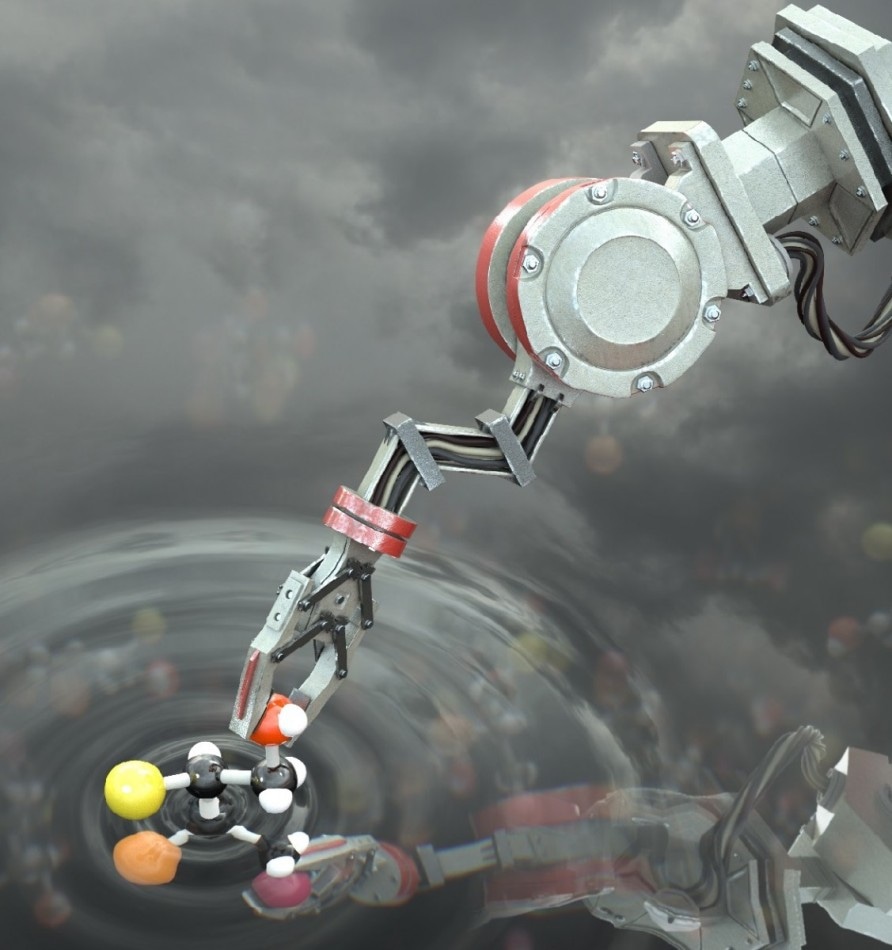Sep 21 2017
The world’s first ‘molecular robot’ has been created by a team of Scientists at The University of Manchester. This robot can perform basic tasks as well as build other molecules.
 Artist's impression of the molecular robot manipulating a molecule. (Image credit: Stuart Jantzen, www.biocinematics.com)
Artist's impression of the molecular robot manipulating a molecule. (Image credit: Stuart Jantzen, www.biocinematics.com)
Being only a millionth of a millimeter in size, these small robots can be programmed to move and build molecular cargo, with the help of a small robotic arm.
Each individual robot is made up of just 150 nitrogen, oxygen, hydrogen and carbon atoms and is capable of manipulating a single molecule. To give a better idea of the robot size, imagine a billion billion of these robots piled on top of each other. It would still remain the same size as a single grain of salt only.
The robots work by performing chemical reactions in special solutions which can then be controlled and programmed by Scientists to carry out the basic tasks.
Such robots could be employed for advanced manufacturing processes, medical purposes and even building molecular factories and assembly lines in the future. The research will feature in the 21st September edition of Nature today.
All matter is made up of atoms and these are the basic building blocks that form molecules. Our robot is literally a molecular robot constructed of atoms just like you can build a very simple robot out of Lego bricks. The robot then responds to a series of simple commands that are programmed with chemical inputs by a Scientist. It is similar to the way robots are used on a car assembly line. Those robots pick up a panel and position it so that it can be riveted in the correct way to build the bodywork of a car. So, just like the robot in the factory, our molecular version can be programmed to position and rivet components in different ways to build different products, just on a much smaller scale at a molecular level.
Professor David Leigh, Head of the research, School of Chemistry, The University of Manchester
One main advantage of having machinery that is so small is that it drastically lowers the demand for materials, can enhance and speed up drug discovery, significantly reduce power requirements and rapidly increase the miniaturization of other products. Thus, the prospective applications for molecular robots are highly diverse and exciting.
Molecular robotics represents the ultimate in the miniaturization of machinery. Our aim is to design and make the smallest machines possible. This is just the start but we anticipate that within 10 to 20 years molecular robots will begin to be used to build molecules and materials on assembly lines in molecular factories.
Professor David Leigh, Head of the research, School of Chemistry, The University of Manchester
While building and operating such tiny machine is very complicated, the team used techniques that are based on simple chemical processes.
Prof Leigh said, "The robots are assembled and operated using chemistry. This is the science of how atoms and molecules react with each other and how larger molecules are constructed from smaller ones. It is the same sort of process scientists use to make medicines and plastics from simple chemical building blocks. Then, once the nano-robots have been constructed, they are operated by scientists by adding chemical inputs which tell the robots what to do and when, just like a computer program."